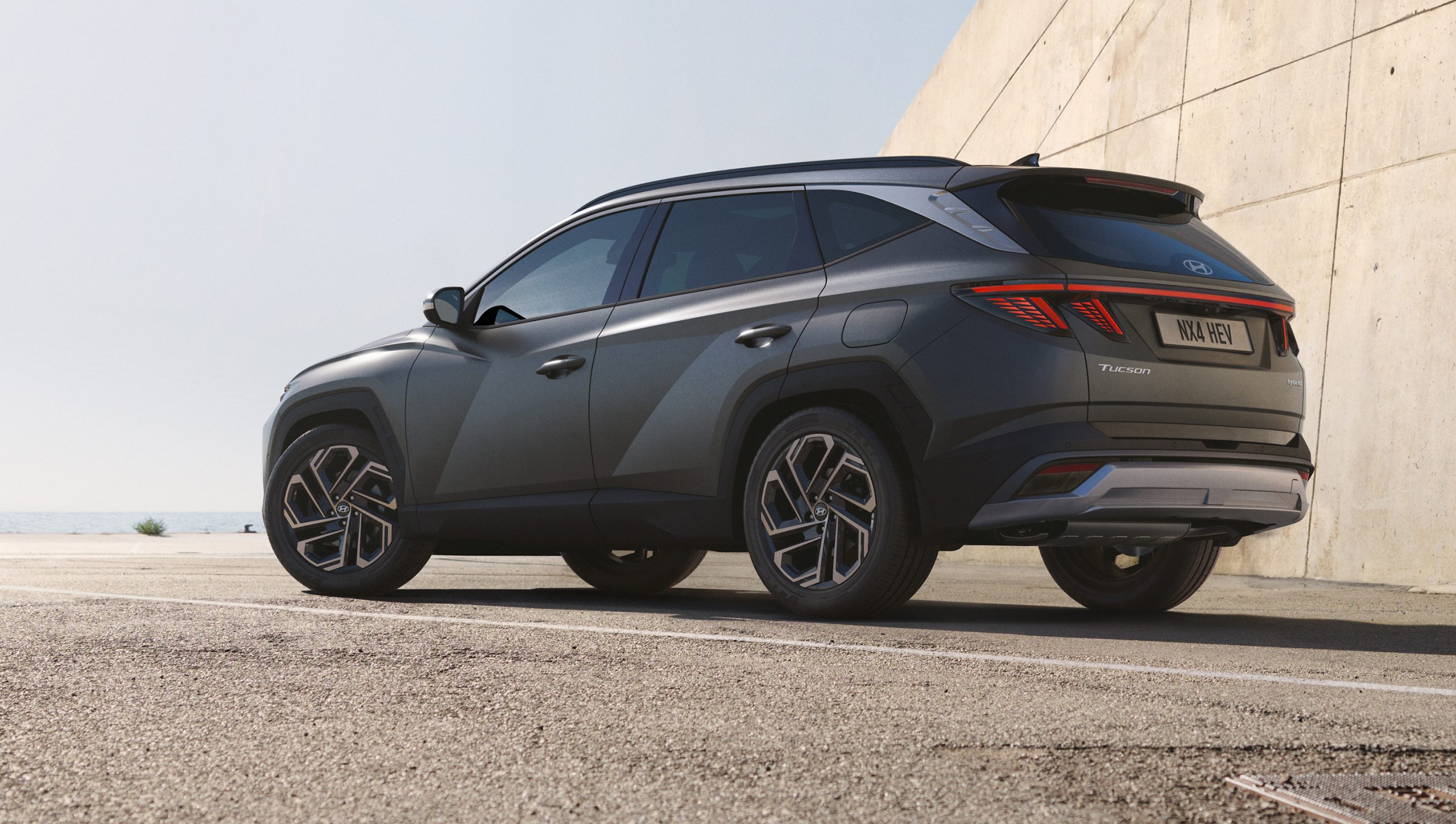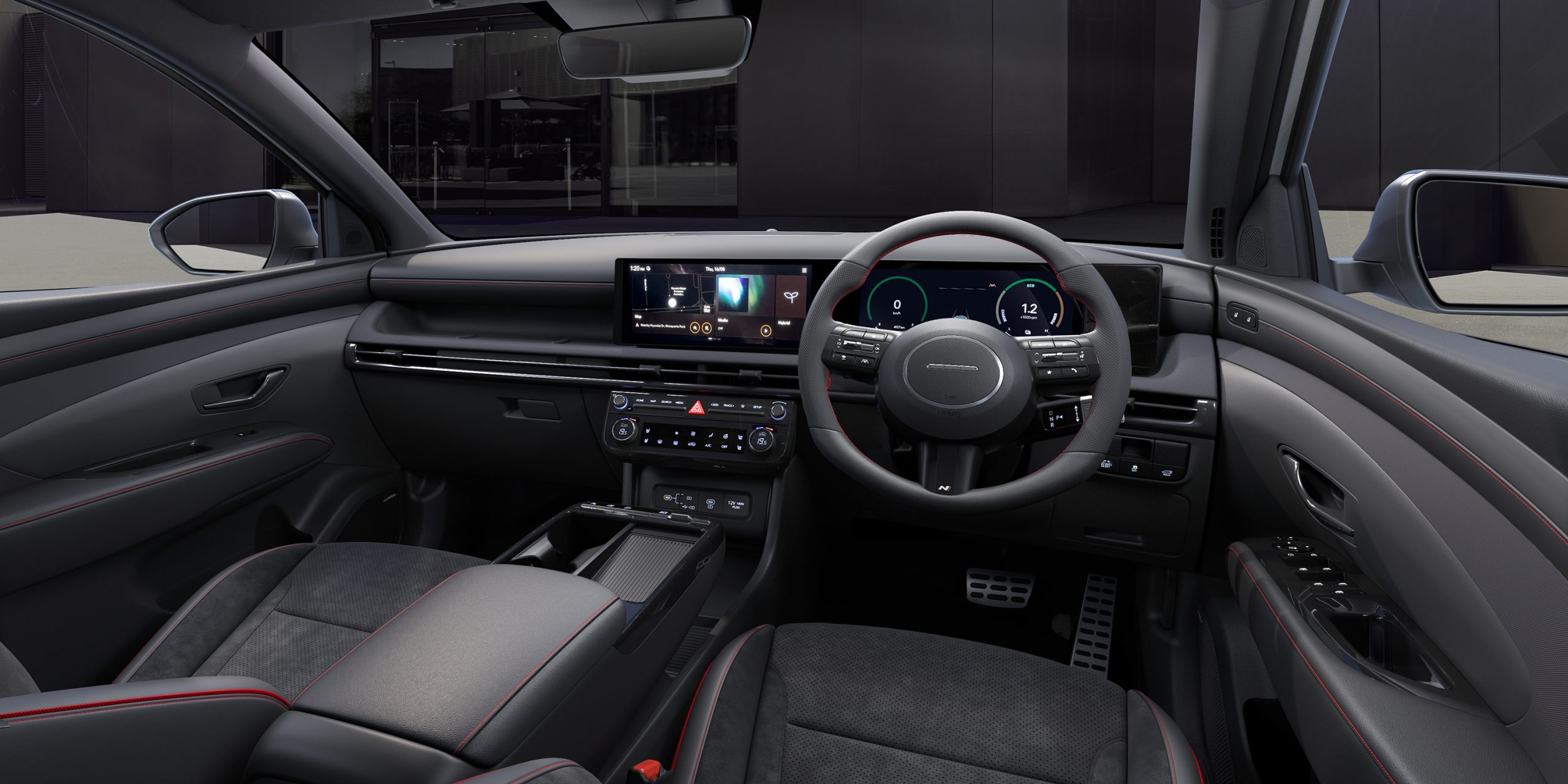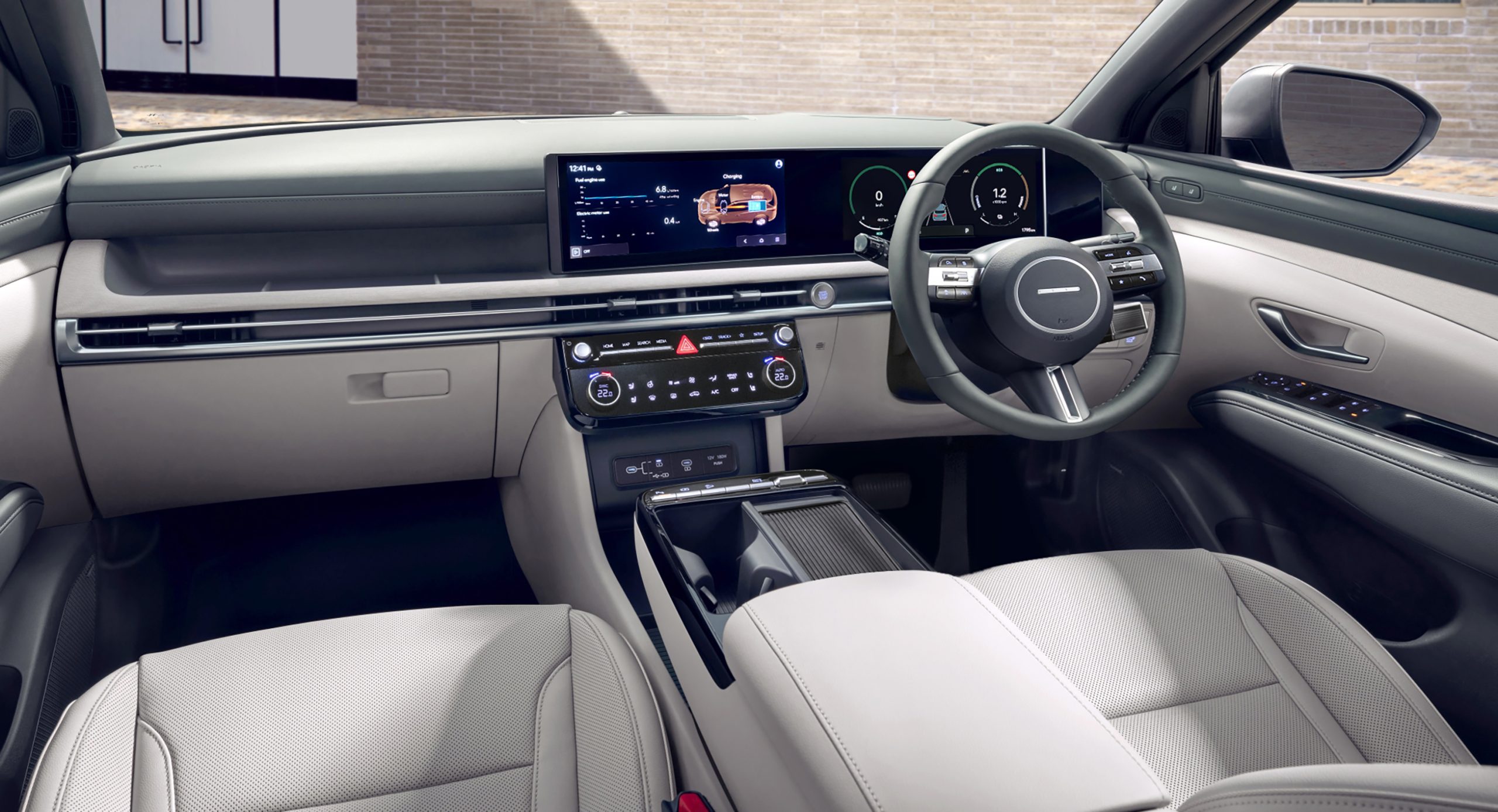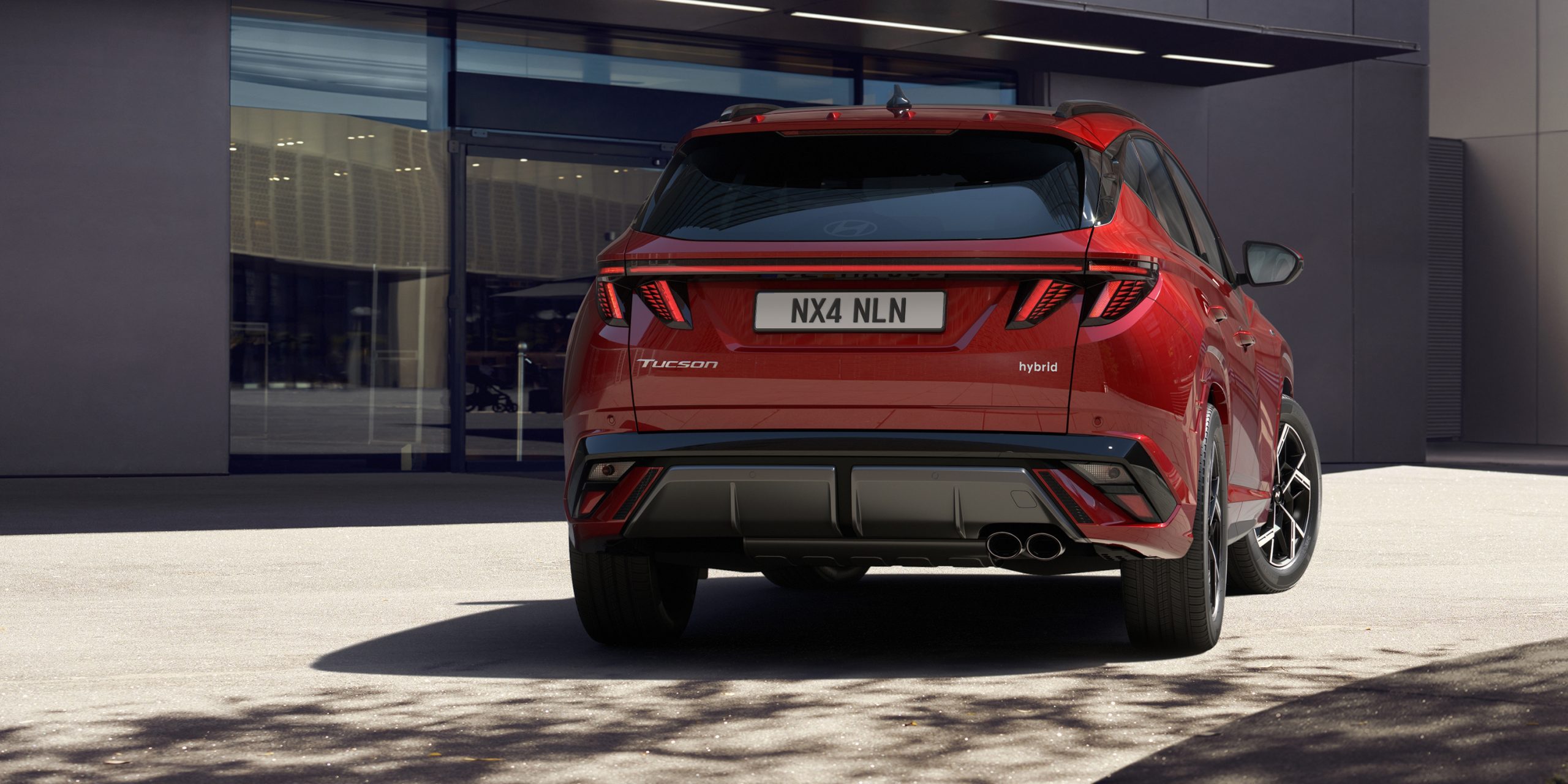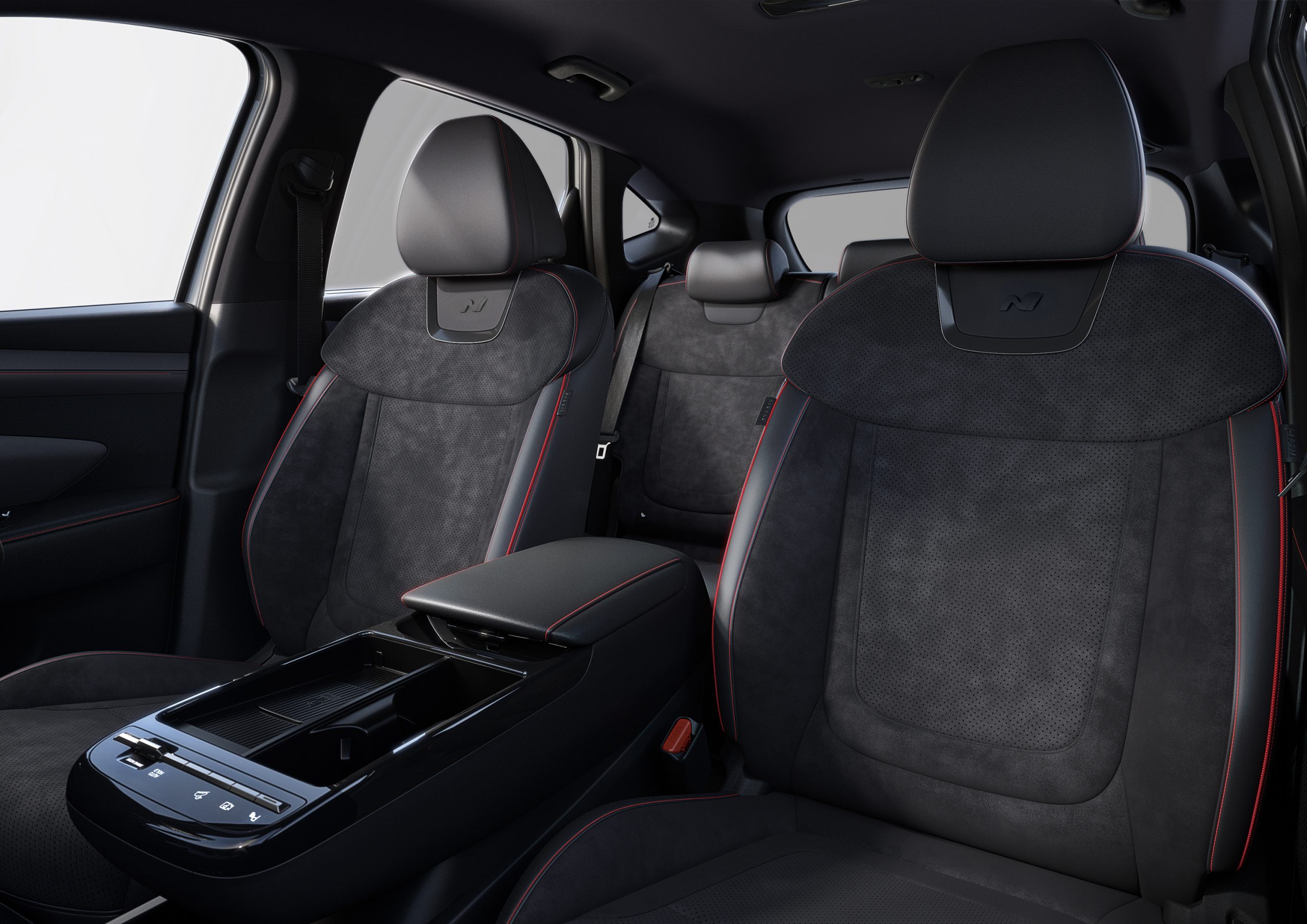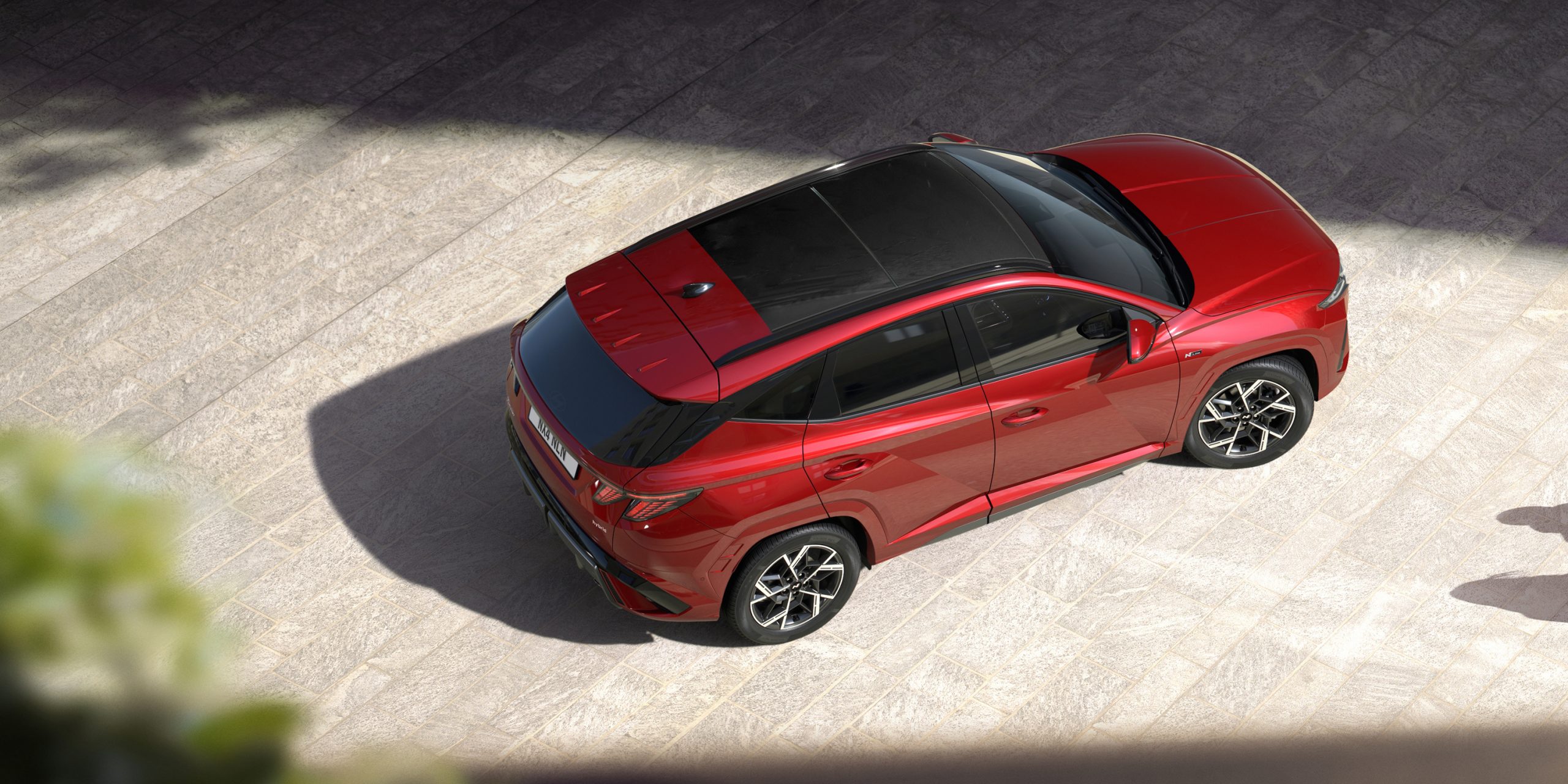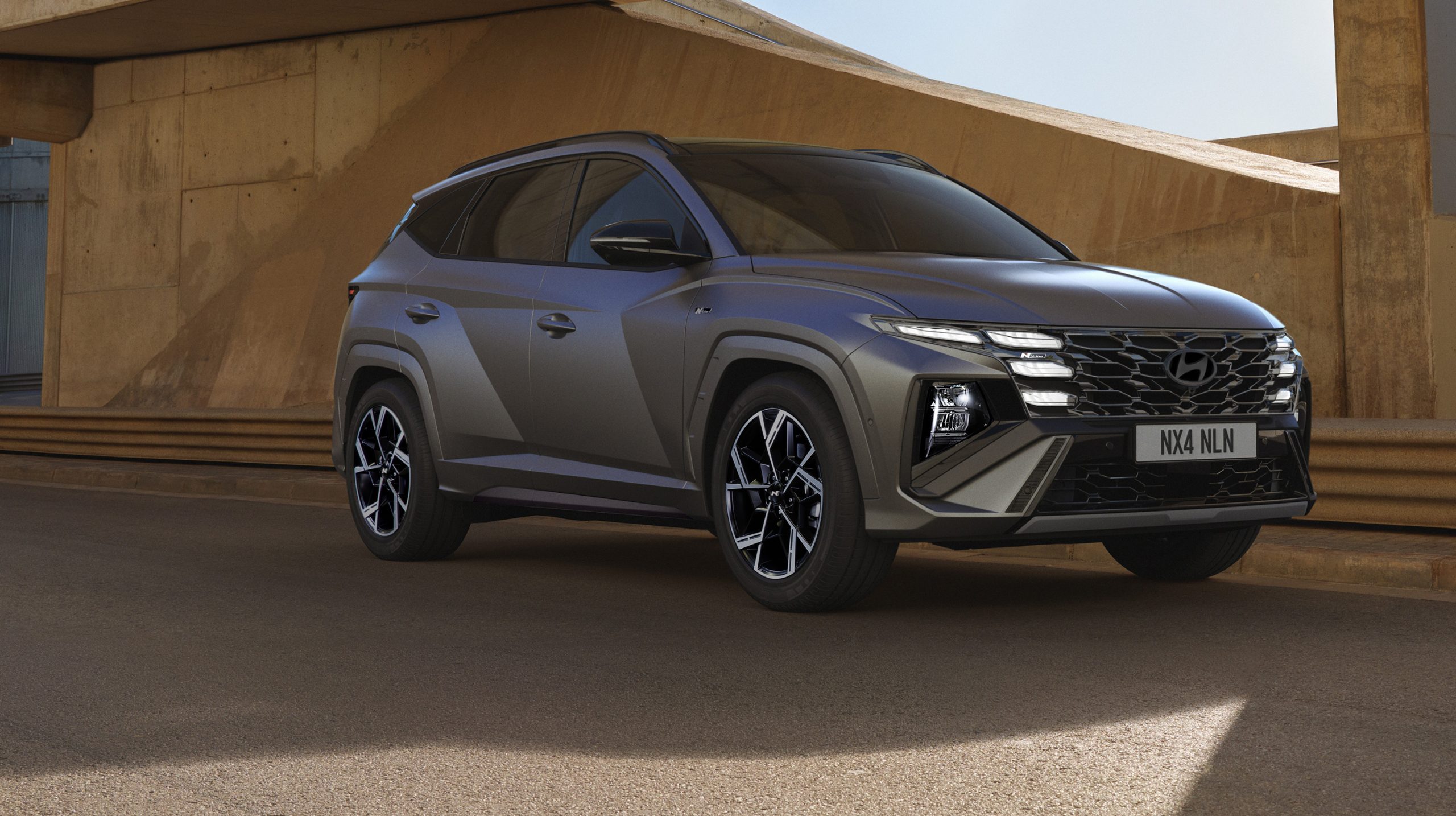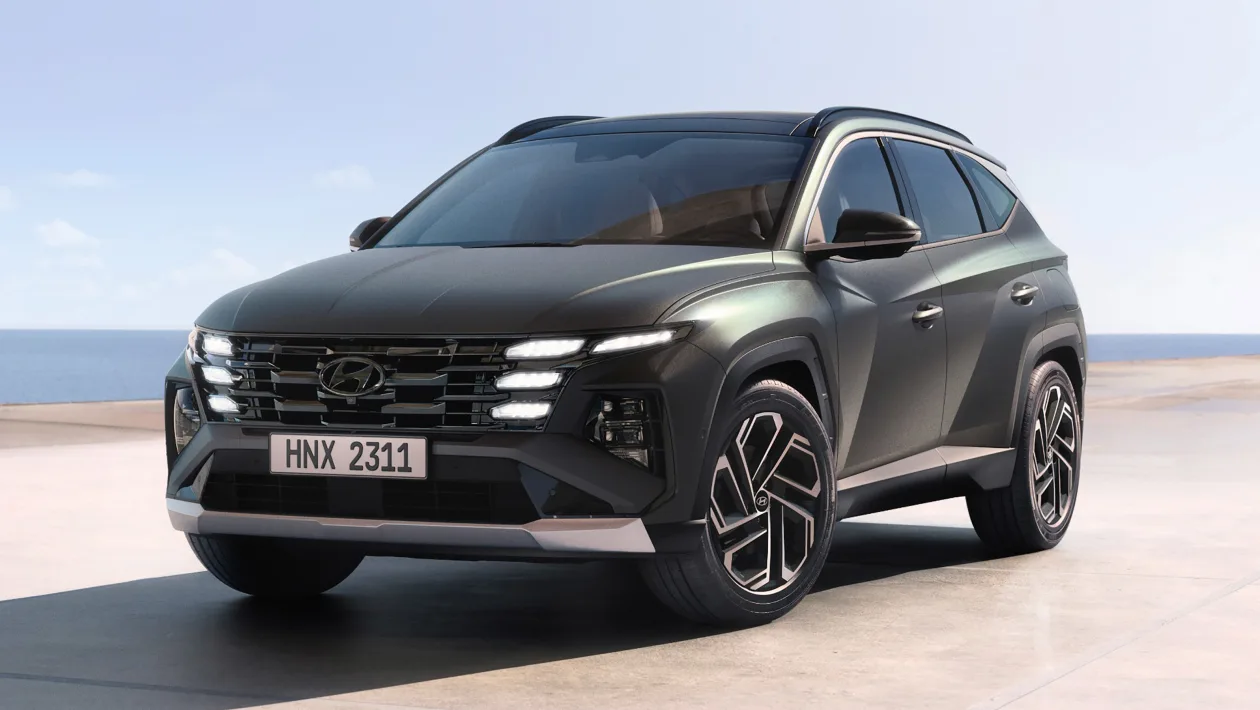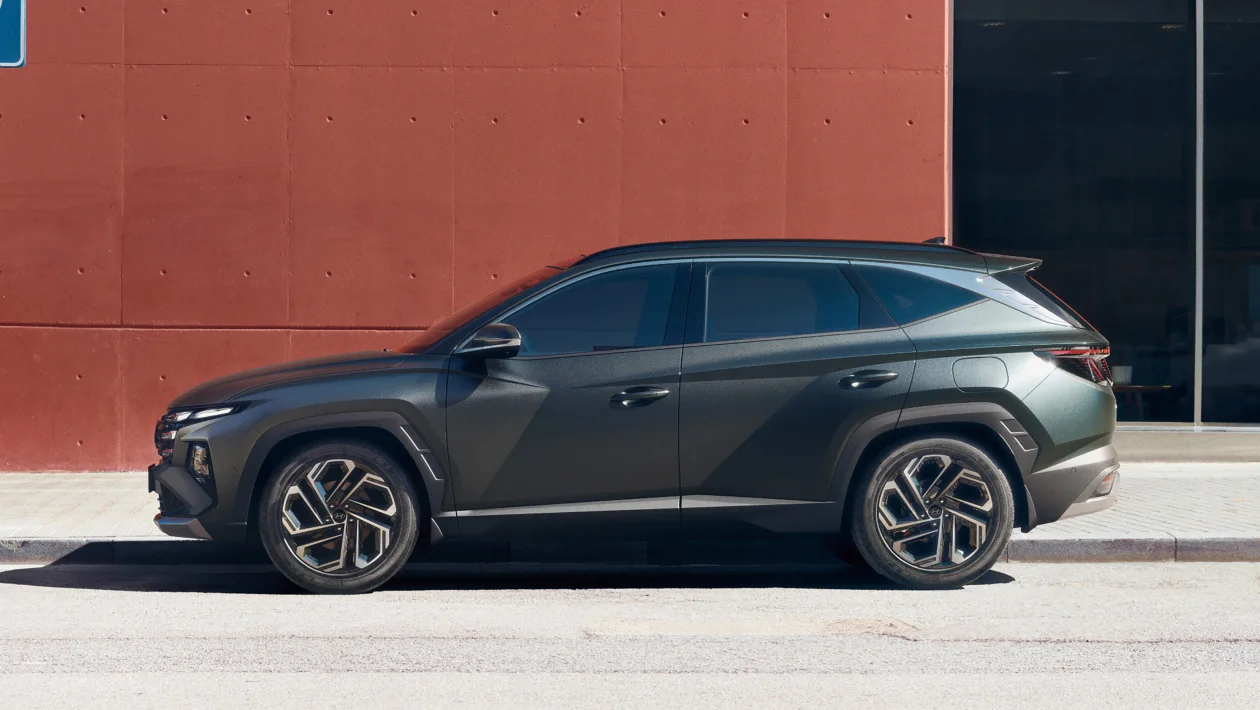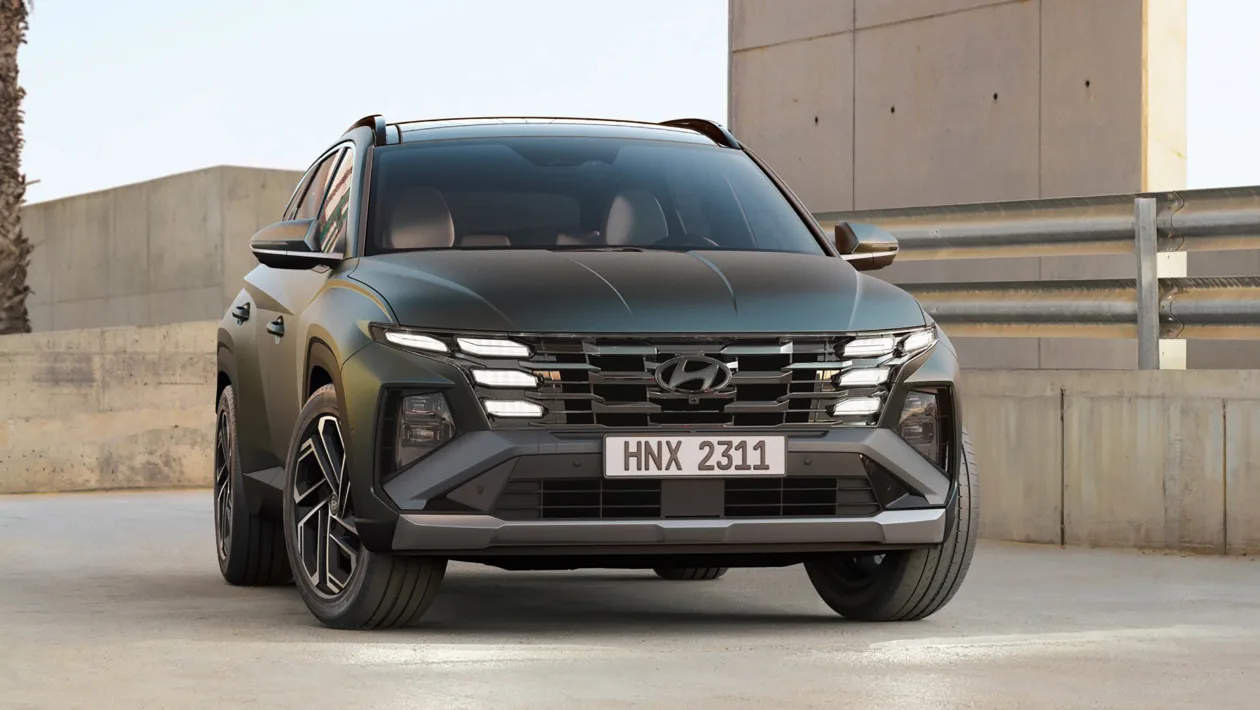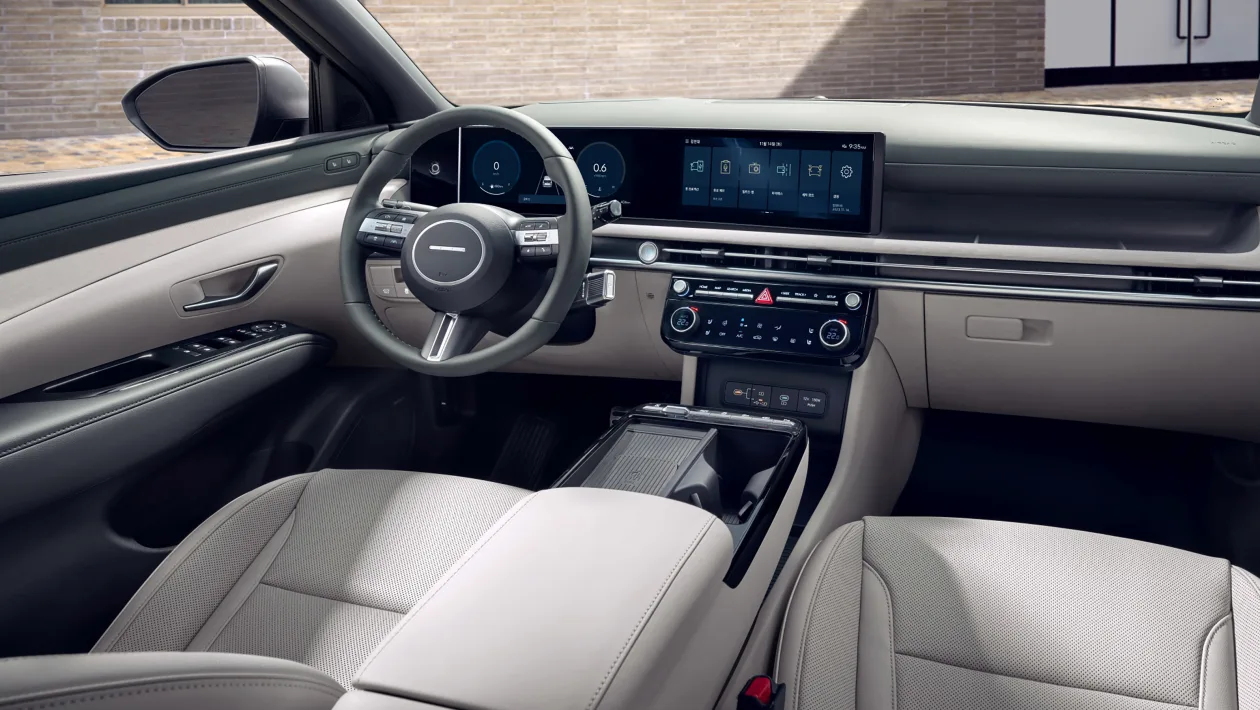The refreshed 2025 Hyundai Tucson, unveiled in November last year, is now on sale in Australia with subtly updated looks, a hybrid engine option and loads of new technology
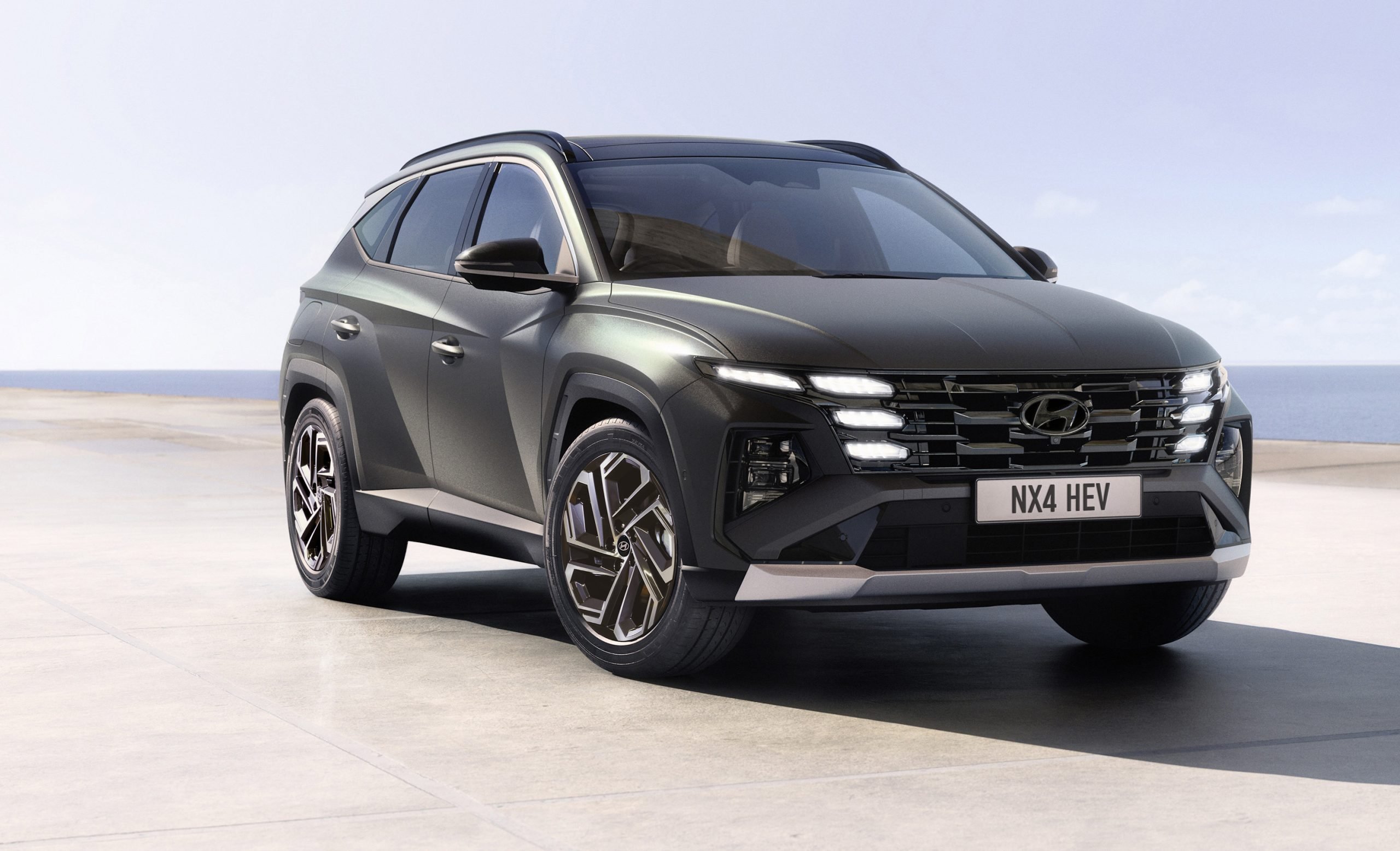
IN BRIEF
- 2025 Hyundai Tucson debuts lightly refreshed styling
- New hybrid option joins line-up
- ‘Panoramic curved display’ debuts in cabin, along with a 12.0-inch head-up display
- Highway Driving Assist (HDA) system added to safety list
- Bluelink Connected Car Services and over-the-air (OTA) software updates featured
- 1900kg towing capacity for hybrid models
- 2025 Hyundai Tucson priced from $39,100 before on-road costs
Styling
For its midlife update, the 2025 Hyundai Tucson gets a new-look grille and subtly redesigned lighting, along with new bumpers at both ends. New wheel designs are also in the mix.
Go for the N Line exterior pack and the changes again include new “motorsport-inspired” bumper designs, including a diffuser-styled skid plate at the rear, along with new 19-inch alloy wheels and N Line badges.
As before, the Tucson’s N Line option remains a styling pack rather than the warmed-up performance upgrade seen in the i30 range. Why Hyundai hasn’t taken up the obvious option of a fast Tucson flagship continues to elude us…
Inside, there’s a redesigned dash and a new ‘floating’ centre console, along with Hyundai’s latest steering wheel design that swaps out the italic H logo for the curiously different four-dot design that represents H in morse code. Why not?
Features
In the cabin, the refreshed 2025 Hyundai Tucson gets the same big dual-screen curved display making its way across most new Hyundai and Kia models – and, for that matter, the rest of the market.
Those screens, made up of two 12.3-inch displays, offers control and visibility of digital radio, wireless Apple CarPlay and Android Auto (including Google Fast Pair for bluetooth on Android devices), Hyundai’s Bluelink remote connectivity system, over-the-air updates, user profile selection and a swipe-down Quick Control menu (think of the control panel on your phone). Elite and Premium grades also come with Bluelink’s connected satellite navigation and life traffic updates.
All of this is built around Hyundai’s new ‘Seon’ Connected Car Next-Generation Cockpit interface – more readily known as CCNC (styled ccNC).
The updated Tucson also gets an expansive 12.0-inch head-up display (HUD) projected onto the windscreen, “presenting key driving and navigation information in the driver’s line of sight so they can keep their eyes on the road at all times”.
We’re not done with displays though, because the Tucson also boasts a 6.6-inch ‘touch-type display’ with capacitive icons dedicated to dual-zone climate controls, internal air circulation function, driver-only fan control for hybrid models, heated and ventilated seat controls, and heated steering wheel controls.
At last moving away from screens, the 2025 Hyundai Tucson takes a cue from its all-electric brother the Ioniq 5, relocating the steer-by-wire gear selector from the centre console to a more out-of-the-way position on the steering column.
Replacing the outgoing model’s lever in entry models and buttons in higher-spec variants, the updated Tucson now has an additional storage spot alongside the cup holders that some drivers would have previously used as an impromptu home for their phone. This new spot is a fast wireless phone charger with an integrated fan to keep your device from overheating.
| 2025 Hyundai Tucson features | |
|---|---|
| Exterior: | Comfort & convenience: |
| Silver Grille with Silver H emblem | 4″ full digital instrument cluster |
| 18” Alloy wheels w/full size spare | Wireless Charger |
| LED combination taillights | Remote start (with Smart key) |
| LED headlights | Smart key with Push button start |
| Roof rails | Acoustic windshield glass |
| Interior: | Auto up/down windows all windows |
| Cloth seats | Multimedia & connectivity: |
| LED lighting | 12.3″ Multimedia display |
| Leather-appointed steering wheel | Bluelink w/ OTA Updates |
| Climate: | Wireless phone charger |
| 6.6″ touch-type climate control display | Hybrid: |
| Dual-zone climate control | Space Saver Spare Wheel, Smart regeneration breaking, E-Motion Drive, After-blow system |
| 2025 Hyundai Tucson Elite features | |
|---|---|
| Exterior: | Electronic chromic mirror (ECM) |
| Dark chrome radiator grille with Dark Silver H emblem | Solar windshield & front door glass + heated |
| Satin Chrome Mirror Line | Power Opening Tailgate |
| Rain Sensor | Multimedia & connectivity: |
| Interior: | Navigation w/Bluelink live traffic |
| Leather appointed seats | AWD locking + HTRAC (AWD only) |
| Comfort & convenience: | Hybrid: |
| Heated front seats | Space Saver Spare Wheel, Smart regeneration breaking, Terrain Mode (AWD only), E-Motion, After-blow system |
| Power driver seat |
| 2025 Hyundai Tucson Elite features | ||
| Exterior: | Comfort & convenience: | Multimedia & connectivity: |
| 19” alloy wheel | Memory driver seat (IMS) + Power Passenger | BOSE 8-speaker premium audio |
| Sunroof | Walk-In device (Passenger seat) | |
| Projector LED headlights | Heated Steering Wheel | |
| Intelligent Front- Lighting System | Heated & ventilated front seats | |
| Interior: | Heated 2nd row outboard seats | |
| Ambient interior lighting | Head Up Display (HUD) | |
| Hybrid Exclusive specification summary: | ||
| Space Saver Spare Wheel | Smart regeneration breaking | Terrain Mode (AWD only) |
| E-Motion | After-blow system | |
| N Line pack | ||
| Exterior: | 19- Inch wheels | Dark Metal interior trim highlights |
| Dark Silver Grill | Body Colour Cladding | Black headlining |
| Dark Silver H emblem | Rear Spoiler | Alloy pedals |
| Hidden Daytime running lights | interior: | Sport scuff plates |
| Gloss Black outside mirror | Suede Leather-appointed | Seat with back panel with pockets* |
| Projector LED headlights** | Steering wheel | 12.3” full digital instrument cluster* |
| Intelligent Front- Lighting System** | Active Red air vent/seat highlights | Shift By Wire (over 2.0 MPi) |
| Roof Rack Gloss Black | ||
| NOTE: | * Above features standard on Elite | ** Above features standard on Premium |
Safety
Standard safety with the 2025 Hyundai Tucson includes a number of active driver assistance systems, but the new advanced Highway Driving Assist (HDA) is limited to the Elite grade and above.
| 2025 Hyundai Tucson safety features | |
|---|---|
| Parking Distance Warning F/R (PDW) | Intelligent Speed Limit Assist (ISLA) |
| Leather-appointed steering wheel | Lane Following Assist (LFA) |
| 7 airbags | Lane Keeping Assist (LKA) |
| Rear Occupant Alert Logic type (ROA) | Manual Speed Limit Assist (MSLA) |
| Rear View Monitor (RVM) | Parking Collision Avoidance Assist |
| Forward Collision Avoidance (FCA 1.5) | Smart Cruise Control (SCC) |
| FCA car/ped/cyc/moto | Parking Distance Warning F/R (PDW) |
| FCA JT turning / crossing | Rear Occupant Alert Logic type (ROA) |
| FCA Direct oncoming | Rear View Monitor (RVM) |
| FCA Lane change oncoming / side | Safe Exist Assist (SEA) |
| Blind-Spot Collision Avoidance (BCA) | Tyre Pressure Monitoring System |
| Driver Attention Warning (DAW) | |
| High Beam Assist (HBA) |
| 2025 Hyundai Tucson Elite safety adds: |
|---|
| Hyundai Smartsense including: |
| Nav-based Smart Cruise Control (NSCC) |
| Highway Driving Assist (HDA) |
| Rear Occupant Alert – sensor type |
| 2025 Hyundai Tucson Premium safety adds: |
|---|
| Parking Collision-Avoidance Assist: Reverse (PCA-R) |
| Parking Distance Warning: Front/Side/Reverse (PDW) |
| Surround View Monitor (SVM) |
| Blind View Monitor (BVM) |
Power
The entry-level power option with the 2025 Hyundai Tucson is a 115kW/192Nm 2.0-litre four-cylinder petrol engine, matched to a six-speed automatic transmission and front-wheel drive (FWD). Fuel consumption is listed at 8.1L/100km.
A 132kW/264Nm 1.6-litre turbo four-cylinder petrol engine is available in Elite and Premium spec, matched to a seven-speed dual-clutch automatic and the option of FWD or all-wheel drive (AWD). Fuel consumption is listed at 6.7L/100km for the FWD models and 7.2L/100km in AWD form.
For the new hybrid models, the 132kW/264Nm 1.6 turbo engine is paired with a 47.7kW electric motor (and a 1.49kWh li-ion polymer battery) for a combined output of 172kW. FWD and AWD is available, depending on the model, and fuel consumption for both is listed at 5.3L/100km.
Braked towing capacity is rated at 1650kg for the two petrol engines and 1900kg for the hybrids.
The new Tucson’s hybrid system
e-Motion Drive
e-Motion Drive improves stability and handling by preventing inside-wheel slip during corners.
e-Dynamic Drive
- e-Handling: Better steering and stability.
- e-Traction: Reduces understeer in sharp turns.
- e-EHA: Aids collision avoidance and stability.
- e-DTVC: Ensures stable cornering.
e-Comfort Drive
- e-Ride Gen1: Minimises pitching for comfort.
- e-Ride Gen2: Smooth acceleration based on steering.
Auto Terrain Mode & Baby Mode
Auto Terrain Mode adjusts to snow, mud, and sand using AI. Baby Mode smooths acceleration and reduces parking impacts for enhanced comfort.
Ownership
The 2025 Hyundai Tucson range is sold with a five-year & unlimited-kilometre warranty, along with an eight-year / 160,000km high-voltage battery warranty.
Pricing
2.0 petrol FWD
- Tucson – $39,100
- Tucson Elite – $44,100
1.6 turbo petrol FWD
- Tucson N Line pack – $45,100
- Tucson Elite – $46,100
- Tucson Elite N Line pack – $48,600
1.6 turbo petrol AWD
- Tucson Elite – $48,600
- Tucson Elite N Line pack – $51,100
- Tucson Premium – $55,600
- Tucson Premium N Line pack – $57,100
1.6 T-GDi Hybrid FWD
- Tucson – $45,100
- Tucson N Line pack – $49,100
- Tucson Elite – $50,100
- Tucson Elite N Line pack – $52,600
1.6 T-GDi Hybrid AWD
- Tucson Elite – $52,600
- Tucson Elite N Line pack – $55,100
- Tucson Premium – $59,600
- Tucson Premium N Line pack – $61,100
November 2022: 2024 Hyundai Tucson facelift revealed
The popular Hyundai Tucson SUV has received a mid-life update
We’re big fans of the current generation Hyundai Tucson, and now the wraps have come off the facelifted version, which has been “crafted with European customers in mind” according to Hyundai.
The updated Australian Tucson, sourced from South Korea, is likely to arrive here next year.
Since the fourth-generation Tucson was launched in 2020, many of its rivals have been updated or replaced with newer models – such as the Peugeot 3008, Skoda Karoq and Honda CR-V, so competition to the Hyundai is as tough as ever.
Having caught the revised Tucson testing a multitude of times, we’re not too surprised to see a rather mild update on the outside. Instead of taking on the blocky approach that’s been used for the new Santa Fe, the Tucson retains its existing “Parametric Dynamics” design language.
The distinctive “Jewel Hidden Lights” at the front have been tweaked, as have the grille and lower bumper – but overall it’s easily recognisable as a Tucson. The flanks feature wheelarch extensions in a contrasting grey colour, but on sportier versions like N-Line they should once again be painted in body colour. There are also redesigned alloy wheels, and at the rear the Tucson now has larger skid plates integrated into the bumper.
Hyundai claims its interior changes bring a “harmonious blend of functionality and aesthetics.” The biggest difference here is the repositioning of the central touchscreen to be connected to the driver’s display – just as on the latest Kona. The steering wheel is also borrowed from the Tucson’s smaller sibling, with a new badge in the centre.
In a bid to make the Tucson’s fascia easier to use, Hyundai has ditched touch-sensitive haptic controls for dials for the temperature, and switches for more commonly used climate functions. The gear-selector buttons have been moved from the centre console, free up more storage space.
The Tucson sits on Hyundai-Kia’s N3 platform and this should mean we won’t see any changes to the powertrain offerings. We expect to see the current range of petrol, hybrid and plug-in hybrid powertrains carried over.




